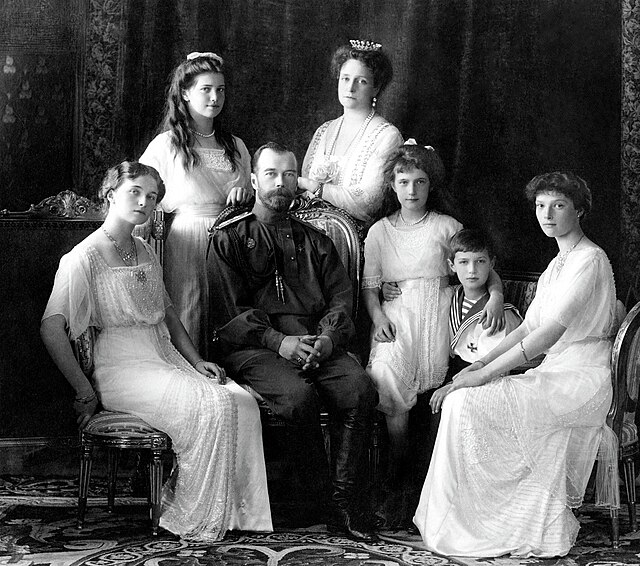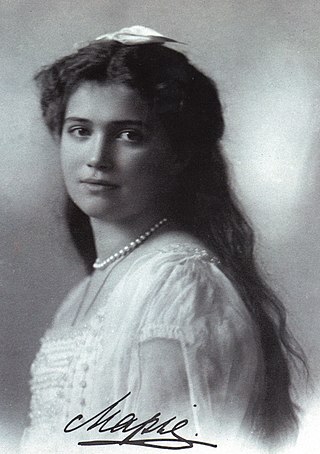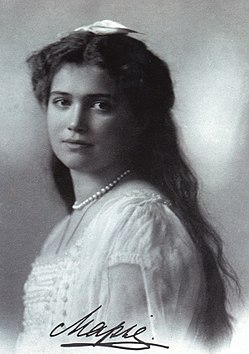Grand Duchess Maria Nikolaevna of Russia
Grand Duchess of Russia (1899–1918) From Wikipedia, the free encyclopedia
Remove ads
Grand Duchess Maria Nikolaevna of Russia (Maria Nikolaevna Romanova; Russian: Великая Княжна Мария Николаевна, 26 June 1899 – 17 July 1918) was the third daughter of Emperor Nicholas II and Empress Alexandra Feodorovna. After she was murdered during the Russian Revolution, she was canonized as a passion bearer by the Russian Orthodox Church.
Remove ads
During her lifetime, Maria, too young to become a Red Cross nurse like her elder sisters, Instead during World War I, was patroness of a hospital and instead visited wounded soldiers. Throughout her lifetime she was noted for her interest in the lives of the soldiers. The flirtatious Maria had a number of innocent crushes on the young men she met, beginning in early childhood. She hoped to marry and have a large family.
She was an elder sister of Grand Duchess Anastasia Nikolaevna of Russia.[2] Her sister Anastasia was famous for stories about her alleged escape from the murder of the royal family for almost 90 years. In the 1990s, it was suggested that the Grand Duchess whose remains were not in the Romanov might be Maria. However, further remains were discovered in 2007, and DNA analysis subsequently proved that the entire Imperial family had been murdered in 1918.[3]
Remove ads
Biography
Early life

Maria was born on 26 June 1899. She was the third child and daughter of Emperor Nicholas II and Empress Alexandra. The birth of a third daughter led to widespread disappointment in Russia.[4] Queen Victoria of the United Kingdom, Alexandra's grandmother and Maria's great-grandmother, wrote, "I regret the third girl for the country. I know that an heir would be more welcome than a daughter."[4]
Nicholas insisted that he was happy with Maria's birth, and he told Alexandra "I dare complain the least, having such happiness on earth, having a treasure like you my beloved Alix, and already the three little cherubs."[5]
At age eleven, Maria apparently developed a painful crush on one of the young men she had met. Alexandra advised her daughter to keep her feelings hidden because others might say unkind things to her about her crush"[6]

As a toddler, little Maria once escaped from her bath and ran naked up and down the palace corridor while her distracted Irish nurse, Margaretta Eagar, who loved politics, discussed the Dreyfus Affair with a friend.[7]
Maria's siblings were Grand Duchess Olga of Russia, Grand Duchess Tatiana of Russia, Grand Duchess Anastasia of Russia, and Tsarevich Alexei of Russia.
Servants addressed the her by her first name and patronym, Maria Nikolaevna. She was also called by the French version of her name, Marie, or by the Russian nicknames Masha or Mashka.
Maria and Anastasia were dressed similarly for special occasions, when they wore variations of the same dress.[8] She tended to be dominated by her enthusiastic and energetic younger sister. When Anastasia tripped people who walked by, teased others or caused a scene with her dramatics, Maria always tried to apologize, though she could never stop her younger sister.[9] Her mother's friend Lili Dehn said that while Maria was not as lively as her three sisters, she knew her own mind.[10]

When Maria was young, she enjoyed flirting with the young soldiers she encountered at the palace and on family holidays. She particularly loved children and, had she not been a Grand Duchess, would have loved nothing more than to marry a Russian soldier and raise a large family.[11] Maria was fond of soldiers from a very early age, according to Margaretta Eagar.
Her first cousin, Louis Mountbatten, 1st Earl Mountbatten of Burma, kept a photograph of Maria beside his bed in memory of the crush he had upon her.[12] In 1910, Louis met the Romanov sisters. He later reflected that "they were lovely, and terribly sweet, far more beautiful than their photographs," and he said that "I was crackers about Marie, and was determined to marry her. She was absolutely lovely."[13]
Like her younger sister Anastasia, Maria visited wounded soldiers at a private hospital on the grounds of the palace at Tsarskoye Selo during World War I. The two teenagers, who were too young to become nurses like their mother and elder sisters, played games of checkers and billiards with the soldiers and attempted to uplift their spirits.[14]

During the war, Maria and Anastasia also paid a visit to a nurses' school and helped to tend to the children. She wrote her father that she thought of him when she was feeding the children and cleaned the gruel running down their chins with a spoon.[15] For a break during the war, Maria, her sisters and mother sometimes visited the Tsar and Tsarevich Alexei at the war headquarters in Mogilev.[16]
Remove ads
Appearance and personality

Maria was a noted beauty. She had light brown hair and large blue eyes."[17] Maria, Duchess of Saxe-Coburg and Gotha, Maria's great-aunt, declared that Maria was a real beauty with enormous blue eyes.[18] Her mother's friend Lili Dehn wrote that she was exceeding fair, dowered with the classic beauty of the Romanovs.[18]
Her French tutor Pierre Gilliard said Maria was tall and well-built, with rosy cheeks.[19] Maria's eyes was often described as "soft and gentle".[20] She had the same charming smile, the same shape of face."[21] Sophie Buxhoeveden said that her eyes were magnificent, of a deep blue, and that her hair had golden lights in it.[21]
She had a talent for drawing and sketched well, always using her left hand.[22] She was uninterested in her schoolwork.[19] Maria could be stubborn and lazy.[23] Her mother complained in one letter that she was grumpy and shouted at the people who irritated her. Maria's moodiness mixed with her menstrual period.[24]
Maria had a kind, sweet personality. Grand Duke Vladimir Alexandrovich of Russia nicknamed her "The Amiable Baby" because of her good nature.[25][26] Her older sisters Olga and Tatiana once referred to Maria as their "stepsister" because she was so good and never got into trouble.[27]
Remove ads
Russian Revolution and captivity

In March of 1917, Maria and her family were under house arrest at Tsarskoye Selo. The family was then moved to the former governor's mansion in Tobolsk by the provisional government that replaced the monarchy.

They were strictly supervised by 300 guards, their windows were sealed and painted over as higher and higher walls were built around the building. The commanding officers could access any of the family's rooms at any time and forced the prisoners to ring a bell to use the lavatory.
Death

Throughout the civil war in 1918, the Bolsheviks grew worried that the White Army would seize the Romanovs, who could be a powerful symbol for the anti-Communist cause. The Ural Regional Soviet decided on June 29 to execute the family and received tentative approval from Moscow. On July 16, the captors were ordered to kill the family because the Red Army forces were retreating.
On July 17, 1918, Maria and her family were executed by Bolshevik agents with gunshots and bayonets at the Ipatiev House in Yekaterinburg. To avoid the corpses' discovery, the guards stripped the bodies of clothing and jewels, mutilated them with sulphuric acid and buried them in the Koptyaki forest.
Remove ads
References
Wikiwand - on
Seamless Wikipedia browsing. On steroids.
Remove ads

